First LINEAGE Exhibition (2009)
 |
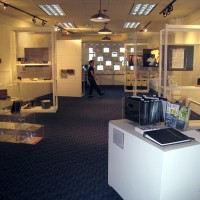 |
 |
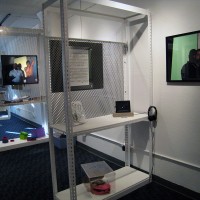 |
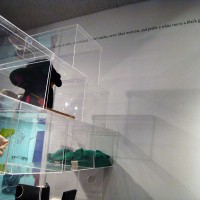 |
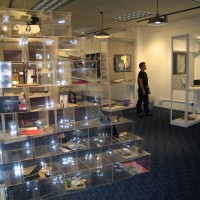 |
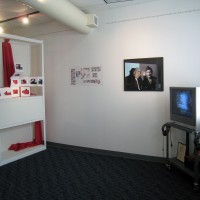 |
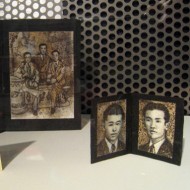 |
The first work to emerge from the Lineage process became an exhibition at the GLBT Historical Society for 4 months in 2009. I designed the installation to suggest an exposed archive and included the work of the first 11 participants. The work was structured on and around steel archive shelving. Archive boxes, both functional and fabricated, served as containers and display units for objects from collections already matched as well as those waiting in the wings. A line of text quotes from participants about their relationship to their match snaked around the gallery walls. And for each matched pair I created a portrait in which the living and the dead occupy the frame at the same time.
LINEAGE Artist Statement
A love-letter on a red napkin, a pair of sequin gloves, an unpublished sci-fi novel, a government security clearance, a gold wheelchair trophy, a photograph of Dining Hall #3 in Topaz, Utah: these are just a few of the artifacts that first lured me to the Gay Lesbian Bisexual Transgender Historical Society archives in San Francisco. It was an easy seduction; I am a sucker for mystery and have always found the visual evidence of a personís life uniquely compelling.
It seems I am not alone. LINEAGE: Matchmaking in the Archive is a project I have developed as the Historical Societyís first artist-in-residence. One by one I match the archives of the dead to living individuals, asking each to invent a response. The resulting encounter resembles a blind date: I think about chemistry, about demographics and mutual interests, about what might emerge from the vault. No one is matched to someone they knew and the collections I select have not yet been in the public eye. Mostly, I use intuition to match creative individuals with an archive that might turn them on. The intense dyadic relationships forming in this process are becoming a kind of lineage, one that resides outside bloodlines and marriage contracts and often outside identity boundaries.
The creative work to come from this process covers a diverse range of media and forms, from live performance to video, sculpture, photography, painting, poetry, letters and musical composition. For each matched pair, I create a formal portrait in both photography and video. For each exhibition, I design a physical installation to contain the work of different participants. So far, the work that is accumulating has been exhibited in a gallery, a cultural center, a public library and on the web. It has also been presented on 4 continents in what I call The Wandering Archives. LINEAGE: Matchmaking in the Archive provides one model for reclaiming historical memory through individual lives, a way to bring archives off the shelf into unexpected creative visibility.
Curatorial Statement, 1st Lineage Exhibition, June 2009
Historical research on "invisible minorities" engenders unconventional strategies, hones specially adapted skill sets, and relies on resources that may not qualify for conservation in traditional archives. For instance, the seventh sense known as gaydar, a sensitivity to detail that serves queer folks as both a survival mechanism and a social networking device, enables us to recognize and acknowledge kinship outside of nuclear family structures. Personal ephemera and apparently trivial historical detritus–a body building magazine, a recipe, a page of sheet music, a necktie–can connect us with past lives whose traces would have been lost were it not for archival collections such as those preserved by the GLBT Historical Society. Working with this kind of material calls for the mobilization of techniques frowned on by conventional historians: poetic intervention, speculative reenactment, story-telling, and fantasy. As Monique Wittig inveighs in Les GuÈrillËres, ìRemember. Or, failing that, invent.î Where there are gaps, we must infer, imagine, project. Or, we must take the gap itself as a statement of fact. This exhibition invites such leaps of imagination, projections that illuminate invisible zones within official accounts of historical and biographical events. These archives, animated by creative impulses, unsettle our ideas about who we are, where we come from, who we want to be, and how we remember.
- Tirza True Latimer
Tirza True Latimer has published work from a lesbian feminist perspective on a range of topics in the fields of visual culture, sexual culture, and criticism. Also an independent curator, her interests include the emergence of lesbian and gay visual communities in early twentieth-century Paris, collaborative and participatory art practices in contemporary art, new genres of public art, the visual politics of identity, art activism, social practices, and the history of photography.